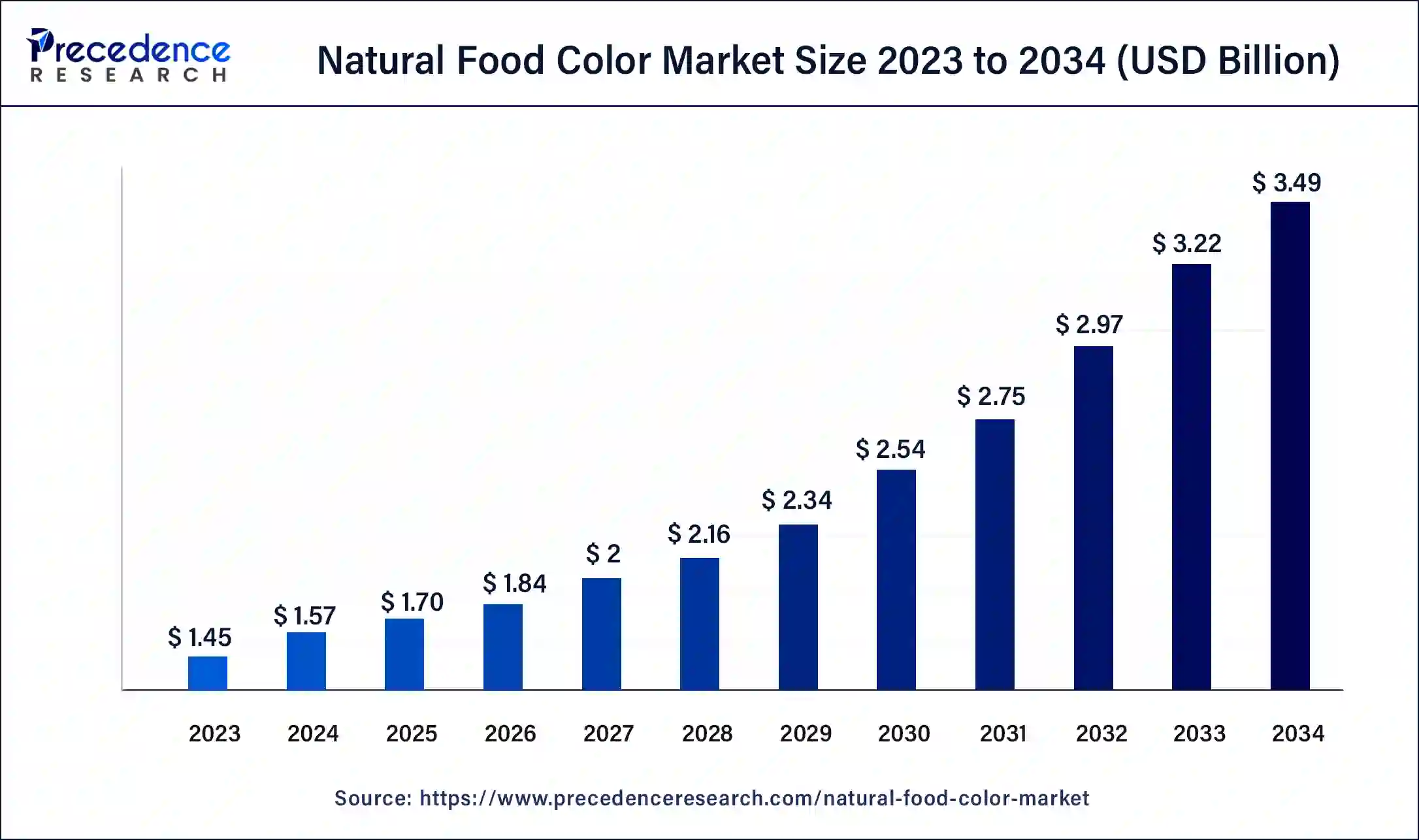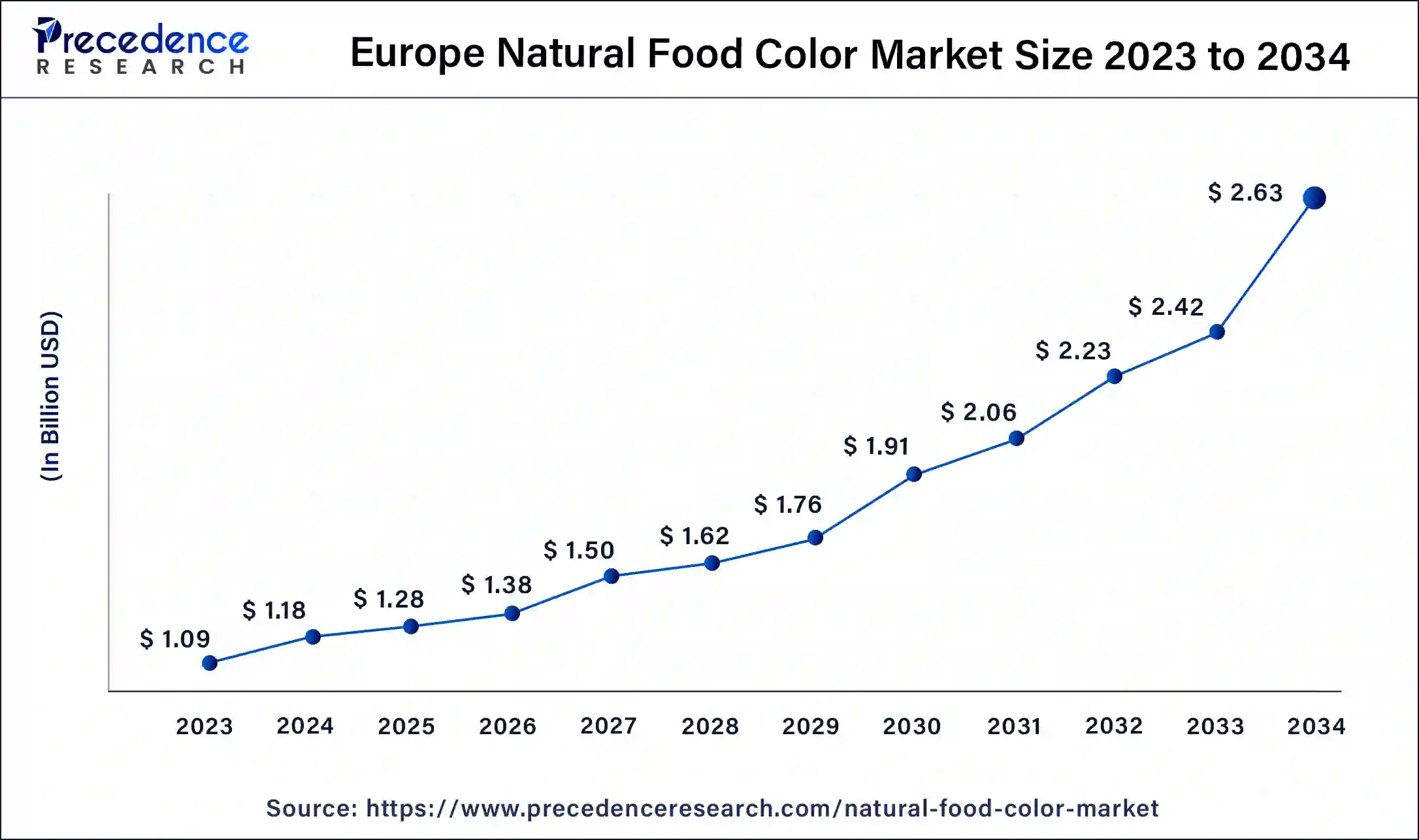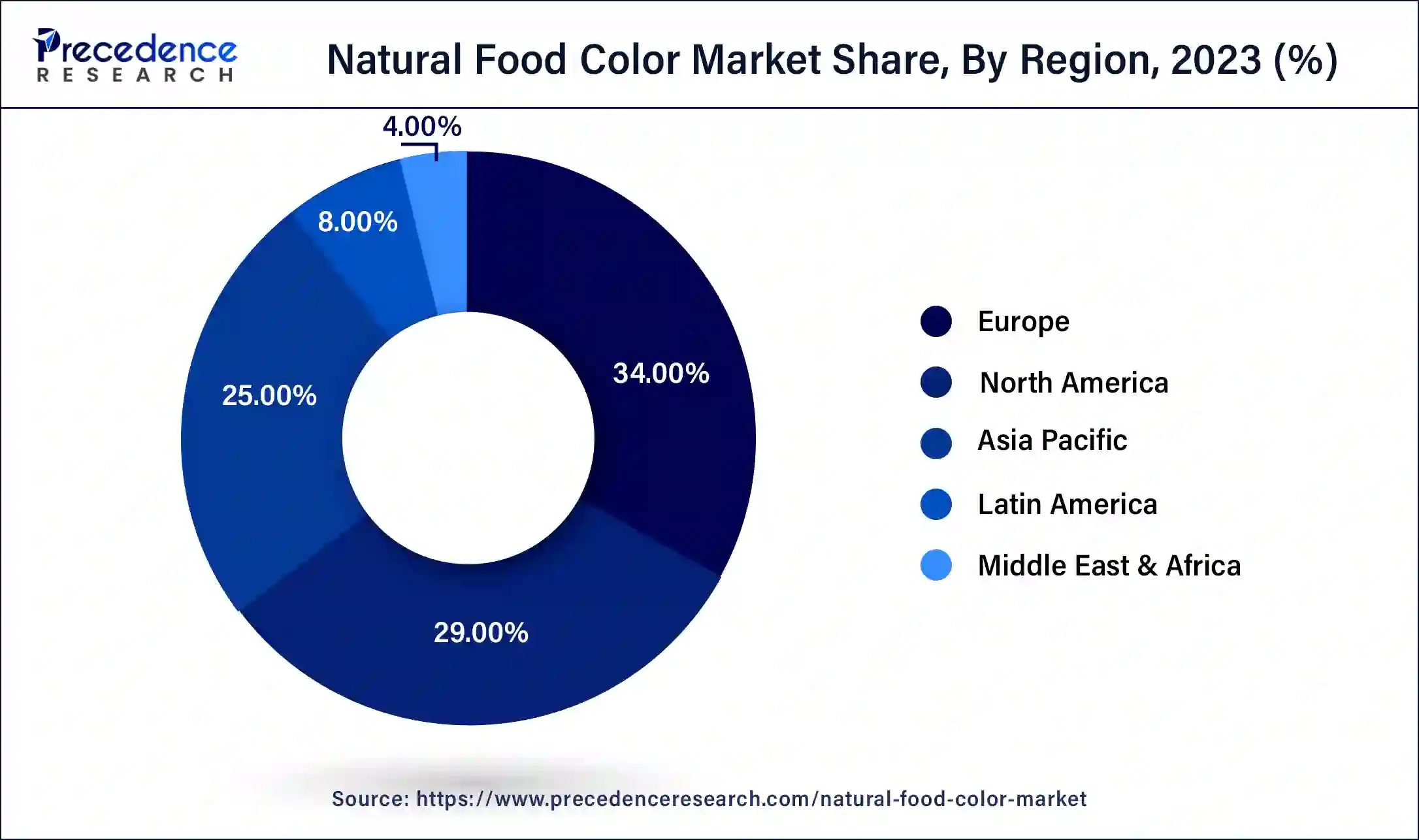October 2024
The global natural food color market size was USD 1.45 billion in 2023, estimated at USD 1.57 billion in 2024, and is expected to reach around USD 3.49 billion by 2034, expanding at a CAGR of 8.31% from 2024 to 2034.
The global natural food color market size is worth around USD 1.57 billion in 2024 and is anticipated to reach around USD 3.49 billion by 2034, growing at a notable CAGR of 8.31% from 2024 to 2034. Increasing regulations for the manufacturing of food products is contributing to market growth.

The Europe natural food color market size reached USD 1.09 billion in 2023 and is predicted to surpass around USD 2.63 billion by 2034, at a CAGR of 8.33% from 2024 to 2034.

Europe dominated the global natural food color market in 2023. The dominance is attributed to the well-established food and beverage industry in European regions like the UK, France, and Germany. The European population prefers natural food colors due to the increasing health awareness that they provide multiple nutritional benefits. Governments in this region also have a regulatory environment that focuses on sustainable production. This opens multiple opportunities for new market players to contribute towards the growth of the natural food color market.

Asia Pacific is anticipated to grow at the fastest rate in the market during the forecast period. Rapid urbanization in countries like China and India is changing lifestyles, which is increasing the need for packed foods and beverages. People prefer foods containing natural colors that are environmentally friendly and provide nutritional benefits. Countries like Japan are constantly focusing on sustainable production, which gives multiple opportunities for new emerging players to contribute to the growth of the natural food coloring market.
Natural food colors refer to a pigment, dye, or any substance obtained from natural sources like animals, vegetables, or minerals to add color to any food or beverage. Some of the natural colors can naturally be obtained from some insects or algae. These colors are considered a better option than synthetic food colors as they are produced by using chemicals that can cause harm to the body and are also non-biodegradable in the environment. Colors like red, violet, and blue are derived from anthocyanins, which are water-soluble pigments found in raspberries, red cabbages, and beetroots. One of the mineral-based sources is calcium carbonate, which creates white coloring in food products.
The global natural food color market is growing significantly due to several health benefits provided by natural colors, and consumers are also turning towards these products. There are many beverages that are being made with natural colors, gaining significant importance and contributing to market growth. There are multiple food options available that contain natural food colors; some of the foods are chocolate gems by Unreal, Magic Spoon Grain Free Fruity Cereal, Tillamook Cheddar Cheese, and many more.
What is the Role of AI in Food Industry?
The emergence of artificial intelligence (AI) is helping many industries in multiple ways to increase their sales and mark significant growth. AI has the capability to analyze huge amounts of data related to natural food colors and help in studying consumer patterns. This can help monitor the quality of the product during production and enhance it according to consumer preferences. The capability to monitor various changes in consumer patterns will potentially help contribute to the growth of the natural food color market in the upcoming years.
| Report Coverage | Details |
| Market Size by 2034 | USD 3.49 Billion |
| Market Size in 2023 | USD 1.45 Billion |
| Market Size in 2024 | USD 1.57 Billion |
| Market Growth Rate from 2024 to 2034 | CAGR of 8.31% |
| Largest Market | Europe |
| Base Year | 2023 |
| Forecast Period | 2024 to 2034 |
| Segments Covered | Ingredient, Application, and Region |
| Regions Covered | North America, Europe, Asia-Pacific, Latin America and Middle East & Africa |
Increasing health consciousness
The increasing health consciousness due to the use of synthetic chemical-based food colors is increasing the health risks, which can lead to allergies, acidity, and many other risks. This brings an opportunity for natural food colors that are extracted from plants and fruits and minimize the health risks. Additionally, the rising disposable incomes in urban cities increase the affordability and preference towards these products, which are gaining significant popularity. Many kinds of research also revealed that the natural ingredients present in food colors contain several health benefits due to the antioxidants present in the natural food colors.
Rising environmental concerns
The increasing global trend is leading towards the adoption of sustainable practices, which is leading to increasing demand for natural food colors. The process of extracting natural colors is sustainable as they are taken from biodegradable sources which are environmentally friendly. This factor plays an important role in attracting multiple investments and support from government bodies and organizations. On the other hand, synthetic chemical-based products are considered harmful to the environment, which increases chemical pollution. Therefore, consumers also prefer natural food colors, which have less impact on the environment and provide additional benefits to the consumers.
Higher costs
The natural food color market has been gaining significant popularity from the past year but there are still concerns that could hamper the market growth. The less availability of natural food color materials increases the overall costs and makes it expensive. This also makes the traditional food colors cheaper, which are being used widely due to less disposable incomes, especially in underdeveloped regions. Many companies should try to invest in production and R&D to make advancements in developing natural food colors.
Increasing focus on R&D
The natural food color market has been gaining significant importance due to the increasing health risks and environmental concerns. This makes it a sensitive topic in the interest of the public as it has the potential risks of affecting their health. As a reason, many organizations are investing heavily in coming up with alternatives for synthetic chemical-based food colors. These investments may benefit the company as it could register significant growth by standing out differently from its competitors. Technological advancements also play a vital role in these researches as they help in improving the overall procedure. The increasing investments are projected to play a vital role in the development of the natural food color market.
Increasing partnerships and collaborations
The increasing collaborations and partnerships tend to offer multiple opportunities in the natural food color market as they help in producing multiple alternatives to synthetic dyes. This is also beneficial for both companies as they can improve their brand value through PR campaigns while promoting these sustainable alternatives in the market. These multiple benefits play a vital role in attracting multiple companies to partner to find solutions in the food industry.
The beta-carotene segment held the largest share of the natural food color market in 2023. It is a carotenoid, which is a pigment that gives veggies and fruits their yellow, orange, and red colors. The body converts this beta-carotene into vitamin A, which is essential for the body. Vitamin A helps improve the immune system, maintain healthy vision, and keep the skin healthy. These benefits stand out as a potential factor in promoting the use of natural colors. Beta-carotene is widely used in multiple food products, such as dairy products and baked goods, and is gaining popularity in various dietary supplements. The use of beta-carotene in various food products plays a vital role in the overall growth of the natural food color market.
The blue spirulina segment is expected to grow at a significant CAGR in the natural food color market during the forecast period. Blue spirulina, also known as phycocyanin, is a pigment that is derived from algae containing various nutrients and antioxidants. It is also rich in protein, which is a good addition to foods and supplements. The blue color also makes a unique and rare appeal in the food product, which makes it different from other foods. The increasing consumer preferences towards blue spirulina. It was frequently used by NASA scientists who were on space missions. It is a sustainable option to add to food products as the process of its cultivation is eco-friendly compared to chemical-based food colors.
The beverages segment dominated the natural food color market in 2023. The growth of this segment is attributed to the rising health awareness among consumers. Individuals prefer natural food colors over synthetic chemical-based colors as they pose a potential health risk. The consumption rate of beverages is increasing day by day for multiple reasons, such as the influence of a busy work schedule. The changing lifestyle plays a key role in changing consumer preferences and adopting these sustainable options. Natural colors also provide unique colors, which is one of the important factors in attracting consumers. Many companies are using natural colors, which will help enhance the overall visual appeal of the beverages and contribute towards the growth of the natural food color market.
The dairy & frozen products segment is expected to grow at the fastest rate in the natural food color market during the forecast period 2024 to 2034. Urbanization and a busy lifestyle are key factors behind the significant increase in the production of dairy and frozen products. People prefer products with additional nutritional benefits that would complete their minimum requirement. Many companies are also coming up with new ideas, like flavored yogurt and ice creams, which contain healthy colors. The increasing demand for these products is leading to the global expansion of the natural colors market. This is also increasing the overall demand for these products, which also helps reduce the overall costs and make them affordable for people, especially in developing regions.
Segments Covered in the Report
By Ingredient
By Application
By Geography
For inquiries regarding discounts, bulk purchases, or customization requests, please contact us at sales@precedenceresearch.com
No cookie-cutter, only authentic analysis – take the 1st step to become a Precedence Research client
October 2024
April 2025
August 2024
January 2025